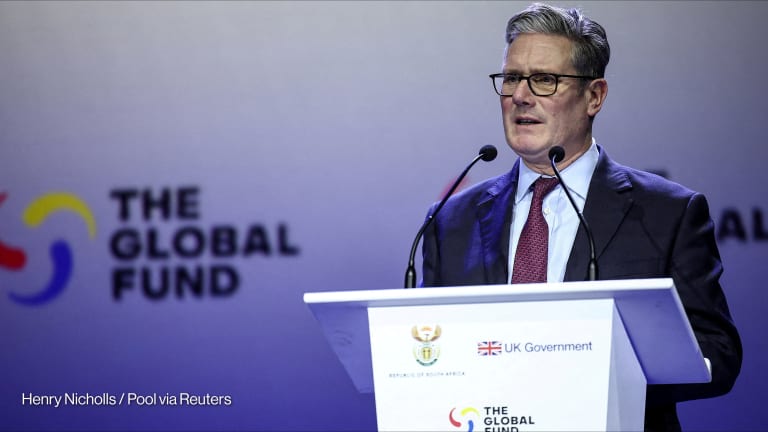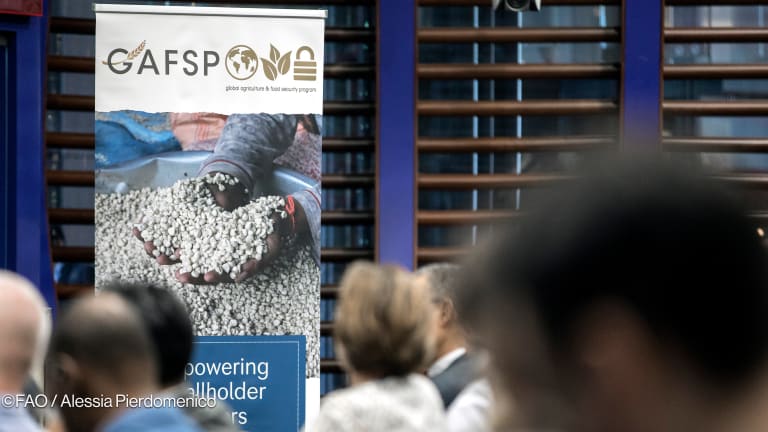
MANILA — The Global Fund to Fight AIDS, Tuberculosis and Malaria hopes to raise $14 billion for its sixth replenishment cycle, but with budget deficits facing some of its largest donors, questions hover on whether the multilateral health partnership will be able to raise the full amount.
“I'm confident that we have a very good investment case ... and that we have very strong support from our donors.”
— Peter Sands, executive director, Global FundIn an interview with Global Fund Executive Director Peter Sands on Thursday — a day before French President Emmanuel Macron announced the bank’s investment case and formally kicked off Global Fund’s fundraising for its 2020-2022 budget cycle — he told Devex how the fund is in “constant dialogue” with the United States, its largest donor, and continues to receive strong bipartisan support in Congress.
The U.S. President's Emergency Plan for AIDS Relief, reauthorized in December by U.S. President Donald Trump, is “an indication of continued [U.S.] support of the fight in this case against HIV,” Sands said.
But concerns remain over PEPFAR’s future financing. For the 2019 fiscal year, the Trump administration’s funding request for PEPFAR was more than $1 billion less compared with the previous budget. And that includes a reduced funding request for the Global Fund.
Global Fund pushes countries to spend faster — or lose funds
The fund placed a deadline to prevent countries with unspent funds using them in the new year. The moves aims to increase predictability of spending and enhance impact, the fund told Devex.
France, which is hosting the replenishment conference for the Global Fund this year in Lyon, is also expected to surpass the European Union’s 3 percent budget deficit ceiling in 2019. Macron’s pledges to cut taxes and raise the minimum wage following the protests that swept the country last year reportedly will also cost the government billions in revenue.
Still, Sands thinks the fund’s traditional donors — many part of the leading industrial nations — will continue to provide the biggest share for its next budget cycle, while mentioning how the fund aims to expand its donor base for the replenishment.
“We have been very actively engaged with donors. Obviously the very big ones, but also many of the smaller ones,” he said.
Following its last replenishment cycle in 2016, the fund added a nonvoting donor seat to accommodate new, emerging bilateral donors, such as China and Saudi Arabia, that are not represented in the board in hopes of further engaging them and encouraging more contributions.
Many of these donors have contributed to the fund, although their contributions have remained significantly smaller compared with the Group of Seven donors, all of whom are represented in the board as voting members. In the current budget cycle, China pledged $18 million.
Russia also made previous contributions to the fund amounting to over $300 million. But it was absent at the donor table the last two replenishment conferences, and Sands said he is “not aware of any indications” of Russia being present in the upcoming one.
Asked how confident he is that the fund’s target resources will be met, Sands said: “you can never take donors for granted, especially when you're asking for what is obviously a very substantial ... amount of money.”
“But as we're approaching this replenishment ... I'm confident that we have a very good investment case, that we have a demonstrable record of delivering results with money that we are given, and that we have very strong support from our donors,” he added.
Not raising the required resources should concern everyone, he said, especially as it can impact the world’s battle against HIV/AIDS, tuberculosis, and malaria.
Nigeria faces a health financing cliff edge
Nigeria remains heavily reliant on foreign funding for programs tackling polio, malaria, HIV, and more. Is it ready for those flows to stop?
Asked how the money will be divided among Global Fund priorities, Sands said the fund will very much follow the pattern they’ve adopted in previous cycles, whose allocation is based on countries’ gross national income per capita and disease burden. A small portion will continue to be part of the fund’s catalytic funding, which the Global Fund chief described as funding for “priorities that don't necessarily fit the country-based approach such as the regional malaria initiative in the Mekong Delta, or dealing with refugees or migrant workers.”
In its current budget cycle, the Global Fund’s catalytic funds were spent on issues such as addressing HIV infection among adolescent girls and young women, and innovations in finding people with TB.
The precise methodology for the allocation will be decided by the Global Fund board in May 2019, he said.








